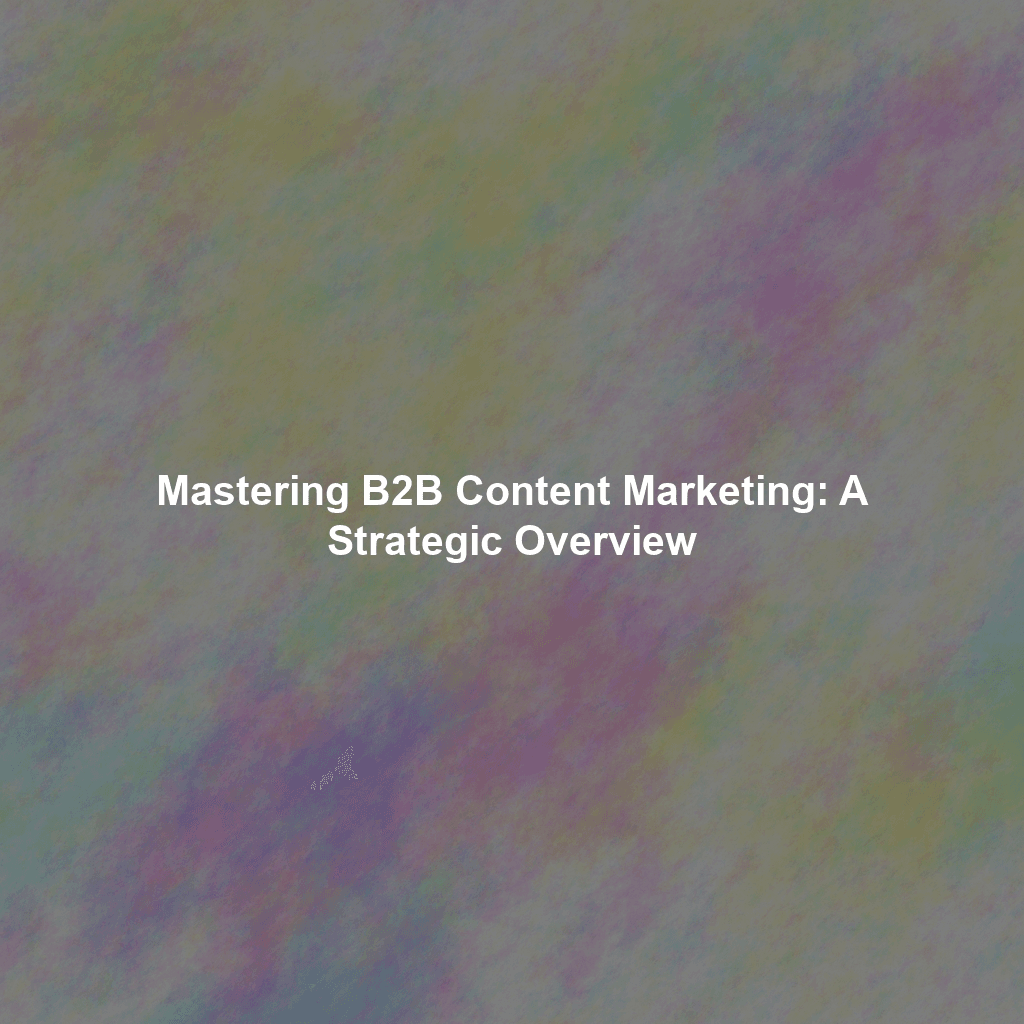Mastering B2B Content Marketing: A Strategic Overview
B2B content marketing has evolved far beyond simply creating blog posts. It’s now a sophisticated, multi-faceted approach that drives lead generation, builds brand authority, and fuels revenue growth. In 2024, a successful B2B content marketing strategy requires a deep understanding of your target audience, a commitment to providing valuable content, and a data-driven approach to measurement and optimization. This comprehensive guide will equip you with the knowledge and tools to build and execute a winning B2B content marketing strategy.
The core principle of B2B content marketing remains consistent: providing valuable, relevant, and consistent content to attract and retain a clearly defined audience — and, ultimately, to drive profitable customer action. This action could be a demo request, a sales call booking, or a direct purchase. However, the *how* has become increasingly complex. Sophisticated buyers are researching solutions independently, consuming content across multiple channels, and expecting a personalized experience. Therefore, your content strategy needs to adapt accordingly.
Defining Your B2B Content Marketing Goals and Objectives
Before diving into content creation, you must define your goals and objectives. Without clear goals, you’ll lack a roadmap and struggle to measure success. Consider the following:
Setting SMART Goals for B2B Content Marketing
Your goals should be SMART: Specific, Measurable, Achievable, Relevant, and Time-bound. Examples include:
- Increase website traffic by 30% in the next quarter. (Specific, Measurable, Achievable, Relevant to website visibility, Time-bound)
- Generate 50 qualified leads per month through content downloads. (Specific, Measurable, Achievable, Relevant to lead generation, Time-bound)
- Improve conversion rates on landing pages by 15% within six months. (Specific, Measurable, Achievable, Relevant to sales, Time-bound)
- Establish thought leadership within the [industry] industry. (This is more qualitative, but still can be measured by metrics like backlinks, social mentions, and media coverage)
Document your goals and regularly review progress. Use analytics tools to track key performance indicators (KPIs) like website traffic, lead generation, conversion rates, and customer acquisition cost (CAC).
Understanding Your Target Audience (Buyer Personas)
A deep understanding of your target audience is paramount. Develop detailed buyer personas that represent your ideal customers. This involves research into their demographics, job titles, pain points, goals, and preferred content formats. Use surveys, interviews, and website analytics to gather insights. Consider the following questions:
- What are their biggest challenges?
- What solutions are they currently using?
- Where do they go for information (e.g., industry blogs, social media, etc.)?
- What are their buying behaviors?
- What are their preferred content formats (e.g., white papers, webinars, videos, etc.)?
By understanding your audience, you can tailor your content to address their specific needs and interests, increasing its relevance and effectiveness. The more specific you are, the better. For example, instead of simply targeting ‘marketing managers,’ create personas for ‘Marketing Manager at a SaaS company,’ or ‘Marketing Manager at a mid-sized manufacturing firm.’
Developing a Robust B2B Content Marketing Strategy
Once you have your goals and audience defined, it’s time to build your strategy. This involves several key components.
Content Planning and Ideation
Content planning is the backbone of your strategy. Start by creating a content calendar that outlines your publishing schedule, content topics, formats, and target audience segments. Brainstorm content ideas based on your buyer personas’ pain points, industry trends, and relevant keywords. Use tools like Google Keyword Planner ([https://ads.google.com/home/tools/keyword-planner/](https://ads.google.com/home/tools/keyword-planner/)) to identify high-volume, low-competition keywords. Consider these content types:
- Blog posts: Informative articles, thought leadership pieces, and industry news.
- Ebooks and white papers: In-depth guides and reports.
- Case studies: Showcase your success stories.
- Webinars: Live or recorded presentations.
- Videos: Explainer videos, product demos, and customer testimonials.
- Infographics: Visually appealing data presentations.
- Checklists and templates: Provide practical value.
- Podcasts: Audio content for on-the-go consumption.
Aim for a mix of content formats to cater to different learning preferences and stages of the buying journey. Make sure to align content topics with the different stages of the sales funnel, from awareness to consideration to decision.
Keyword Research and SEO Optimization
Effective SEO is crucial for driving organic traffic to your content. Conduct thorough keyword research to identify the terms your target audience is searching for. Focus on both short-tail and long-tail keywords. Optimize your content for these keywords by:
- Including keywords in your title tags, meta descriptions, and headings (H2s and H3s).
- Using keywords naturally throughout your content.
- Optimizing image alt text with relevant keywords.
- Building internal and external links. (Link to authoritative sources and related content on your own website).
- Ensuring your website is mobile-friendly and loads quickly.
Use SEO tools like SEMrush ([https://www.semrush.com/](https://www.semrush.com/)), Ahrefs ([https://ahrefs.com/](https://ahrefs.com/)), or Moz ([https://moz.com/](https://moz.com/)) to analyze your competitors and track your keyword rankings.
Content Creation and Distribution
Create high-quality, engaging content that provides value to your audience. Focus on clarity, accuracy, and readability. Use a consistent brand voice and style guide. Once your content is created, distribute it across multiple channels:
- Your website blog.
- Social media platforms (LinkedIn, Twitter, etc.).
- Email marketing.
- Paid advertising (e.g., Google Ads, LinkedIn Ads).
- Guest blogging on relevant industry websites.
- Content syndication.
Promote your content actively and consistently. Consider using social media scheduling tools like Hootsuite ([https://hootsuite.com/](https://hootsuite.com/)) or Buffer ([https://buffer.com/](https://buffer.com/)) to streamline your social media posting.
Content Repurposing
Maximize the impact of your content by repurposing it into different formats. For example, turn a blog post into an infographic, a webinar into a series of short videos, or an ebook into a set of social media posts. This expands your reach and allows you to cater to different content preferences.
Measuring and Analyzing Your B2B Content Marketing Performance
Regularly measure and analyze your content marketing performance to identify what’s working and what needs improvement. Key metrics to track include:
Key Performance Indicators (KPIs) for B2B Content Marketing
- Website traffic: Overall website visits, page views, and bounce rate.
- Lead generation: Number of leads generated, conversion rates, and cost per lead.
- Engagement: Social shares, comments, likes, and time on page.
- Conversion rates: Percentage of visitors who complete a desired action (e.g., download an ebook, request a demo).
- Customer acquisition cost (CAC): The cost of acquiring a new customer.
- Return on investment (ROI): The profitability of your content marketing efforts.
- Backlinks: The number of websites linking to your content.
- Keyword rankings: The position of your content in search engine results pages (SERPs).
Using Analytics Tools to Track Performance
Use analytics tools like Google Analytics ([https://analytics.google.com/](https://analytics.google.com/)) to track your KPIs. Set up goals and track conversions. Regularly review your data and identify trends. Use this data to refine your content strategy, optimize your content, and improve your results. Implement A/B testing on landing pages, calls-to-action, and other elements to improve conversion rates.
Content Audits and Optimization
Conduct regular content audits to assess the performance of your existing content. Identify underperforming content and update or repurpose it. Remove outdated content and redirect it to relevant pages. Optimize your content based on your data and insights. For example, if a particular blog post isn’t performing well, consider updating it with new information, optimizing it for relevant keywords, or promoting it more aggressively on social media.
Building a Sustainable B2B Content Marketing Program
Content marketing is a long-term strategy. It requires consistent effort, patience, and a commitment to providing value. Here are some tips for building a sustainable program:
Building a Content Team or Outsourcing
Decide whether to build an in-house content team or outsource some or all of your content creation. If you choose to build an in-house team, hire skilled writers, editors, designers, and SEO specialists. If outsourcing, vet potential agencies or freelancers carefully and establish clear expectations and communication protocols. Consider a hybrid approach, outsourcing certain tasks while managing the overall strategy in-house.
Budgeting for B2B Content Marketing
Allocate a budget for content creation, distribution, and promotion. This should include costs for content writers, designers, SEO tools, advertising, and content management systems. Be realistic about your budget and track your spending carefully. Remember that a well-executed content marketing strategy can generate a significant return on investment.
Staying Up-to-Date with Industry Trends
The content marketing landscape is constantly evolving. Stay informed about the latest trends, best practices, and algorithm updates. Follow industry blogs, attend webinars, and participate in industry events. Adapt your strategy as needed to stay ahead of the curve.
Examples of Successful B2B Content Marketing Strategies
Let’s look at some examples of successful B2B content marketing strategies:
HubSpot
HubSpot is a leading example of successful B2B content marketing. They offer a wealth of free resources, including blog posts, ebooks, webinars, and courses, all designed to attract and educate their target audience. They focus on providing valuable content related to inbound marketing, sales, and customer service, building a strong brand and driving lead generation.
Salesforce
Salesforce leverages content marketing to build thought leadership and showcase their products’ capabilities. They publish in-depth articles, case studies, and webinars that demonstrate their expertise and help potential customers understand how their solutions can solve business challenges. They also utilize a strong social media presence to amplify their content.
Neil Patel
Neil Patel, through his various online properties, effectively uses content marketing to build his personal brand and promote his marketing services. He provides data-driven articles, videos, and tools that offer actionable advice, establishing himself as an industry expert.
The Future of B2B Content Marketing
The future of B2B content marketing will be shaped by several key trends:
Personalization
Personalization will become even more critical. Marketers will need to create content that is tailored to individual customer needs and preferences. This will involve using data and analytics to understand customer behavior and create personalized experiences.
Video Marketing
Video marketing will continue to grow in importance. Video is a highly engaging format that can be used to educate, entertain, and build relationships with customers. Consider short-form videos for social media, explainer videos, and longer-form video content like webinars.
Interactive Content
Interactive content, such as quizzes, polls, and calculators, will become more popular. Interactive content provides a more engaging experience and helps to capture valuable data about your audience.
AI-Powered Content Creation and Optimization
Artificial intelligence (AI) will play an increasing role in content marketing. AI can be used to automate content creation, optimize content for search engines, and personalize the customer experience. However, always prioritize human oversight and ensure content remains aligned with your brand voice and values.
Conclusion: Building a Winning B2B Content Marketing Strategy
B2B content marketing is a powerful strategy for driving lead generation, building brand authority, and fueling revenue growth. By following the steps outlined in this guide, you can develop a comprehensive content marketing strategy that helps you achieve your business goals. Remember to focus on providing value to your audience, measuring your results, and adapting your strategy as needed to stay ahead of the curve. Consistent effort and a data-driven approach are key to long-term success. Embrace the power of content, and watch your B2B business thrive!
 Skip to content
Skip to content

